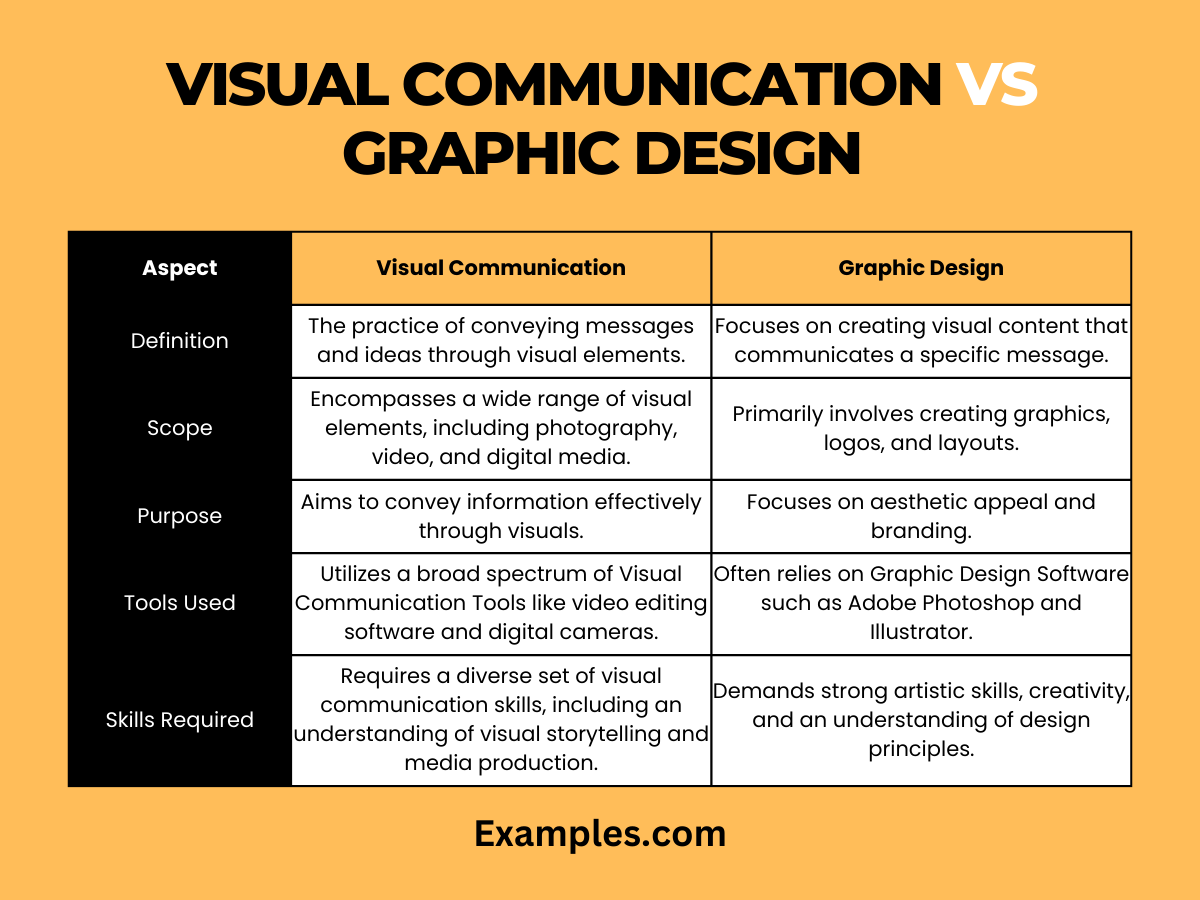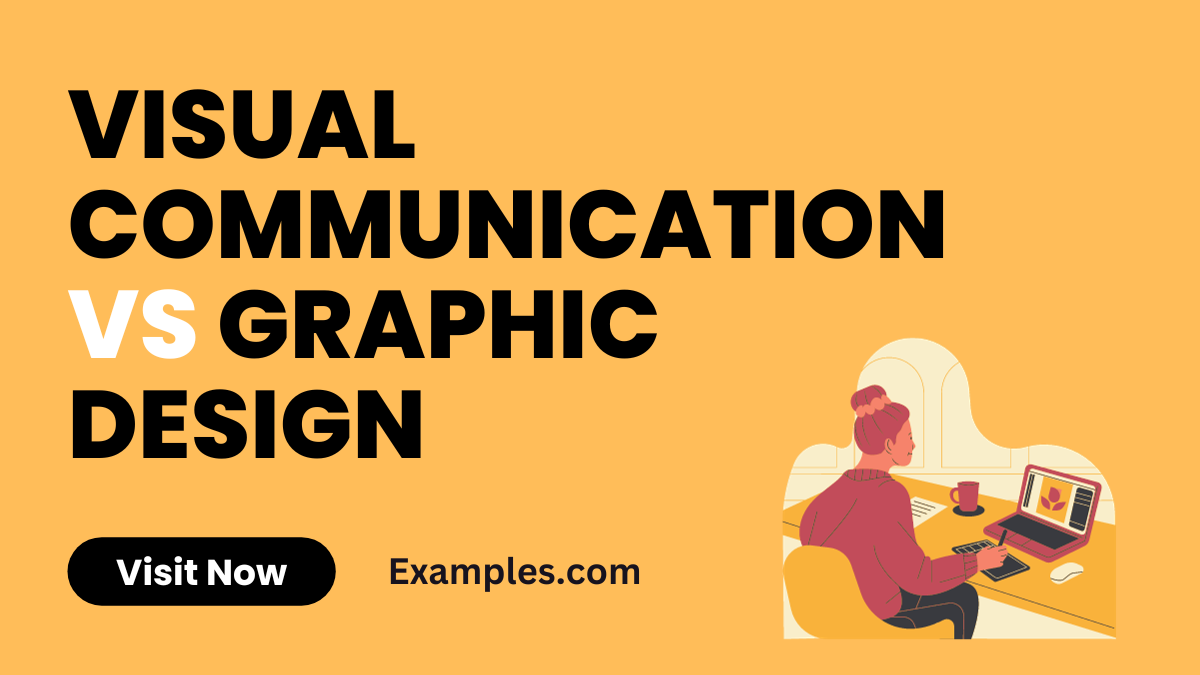Visual Communication vs Graphic Design – 9+ Examples
In this comprehensive guide, we delve into the dynamic realms of Visual Communication and Graphic Design, exploring their unique facets and intersections. Understanding these fields is pivotal in today’s visually-driven world. We’ll unfold various communication examples, showcasing how each discipline employs distinct Graphic Design Techniques and Visual Communication Principles. From digital media to traditional print, our journey includes practical examples, demonstrating the transformative power and impact of visual elements in conveying messages and ideas creatively and effectively.
Download Visual Communication Examples in PDF
Download Graphic Design Examples in PDF
Difference between Visual Communication and Graphic Design

Understanding the distinction between visual communication and graphic design is crucial for professionals in these fields, as well as for those interested in visual communication in the workplace or visual communication in healthcare. Here’s a comparative analysis in table format:
| Aspect | Visual Communication | Graphic Design |
|---|---|---|
| Definition | The practice of conveying messages and ideas through visual elements. | Focuses on creating visual content that communicates a specific message. |
| Scope | Encompasses a wide range of visual elements, including photography, video, and digital media. | Primarily involves creating graphics, logos, and layouts. |
| Purpose | Aims to convey information effectively through visuals. | Focuses on aesthetic appeal and branding. |
| Tools Used | Utilizes a broad spectrum of Visual Communication Tools like video editing software and digital cameras. | Often relies on Graphic Design Software such as Adobe Photoshop and Illustrator. |
| Skills Required | Requires a diverse set of visual communication skills, including an understanding of visual storytelling and media production. | Demands strong artistic skills, creativity, and an understanding of design principles. |
| Application Areas | Found in various fields such as Visual communication in photography, journalism, and Visual communication in healthcare. | Common in branding, marketing, advertising, and web design. |
| Educational Focus | Courses often cover Types of Visual Communication, media theory, and visual literacy. | Focuses on design principles, typography, and color theory. |
| Career Opportunities | Offers a range of visual communication jobs, careers, salaries in media, advertising, and corporate communication. | Career paths include graphic designer, art director, and brand consultant. |
| Key Characteristics | Explores the Characteristics of visual communication like clarity, effectiveness, and accessibility. | Emphasizes aesthetics, layout, and visual impact. |
| Usage in Learning | Plays a significant role in educational settings, as seen in Visual communication in the workplace. | Used in creating educational materials and branding for institutions. |
| Research and Development | Continuously evolving, with insights available in a Visual communication journal. | Keeps up with Graphic Design Trends, adapting to new technologies and styles. |
Both fields, while distinct, are interconnected and often overlap in practice. Understanding these differences and similarities is key to effectively leveraging visual communication and graphic design in various contexts, from creative industries to healthcare and education. The importance of both fields in modern communication cannot be overstated, with each playing a unique role in how we interpret and interact with the world around us. For more detailed insights, exploring a Visual communication journal can provide a deeper understanding of these fields.
10 Visual Communication Examples
Visual communication is a key aspect in conveying messages and ideas through visual elements, encompassing a wide range of Visual Communication Examples. Each demonstrating how visual communication operates in different contexts:
- Infographics: Combines data and graphics for simplified understanding.
- Logos: Represents a brand’s identity visually.
- Social Media Posts: Engages audience through visuals.
- Signage: Provides directional or instructional information.
- Educational Videos: Visual aids for learning.
- Website Design: Visual layout of online platforms.
- Data Visualization: Graphic display of data.
- Advertising Campaigns: Uses visuals to promote products.
- Email Newsletters: Combines text with visuals for effective communication.
- Photojournalism: Conveys stories through photographs.
10 Graphic Design Examples
Graphic design is an intricate art that marries visuals with functionality to communicate messages effectively. It plays a pivotal role in branding, marketing, and storytelling, and is a key aspect in various domains, including Visual communication in the workplace and Visual communication in healthcare.
- Logos: The cornerstone of brand identity, representing the essence of a company visually.
- Business Cards: A personal branding tool that combines design elements to make a memorable impression.
- Brochures: Informative paper layouts that use eye-catching design to convey detailed information.
- Billboards: Large-scale outdoor advertising that demands attention through compelling visual design.
- Website Design: Combines aesthetics and user experience, crucial in visual communication jobs, careers, salaries.
- Social Media Graphics: Tailored designs for platforms like Instagram and Facebook, showcasing Visual Communication Examples.
- Packaging Design: The art of making a product stand out on shelves while communicating its essence.
- Email Templates: Designed to grab attention in a cluttered inbox, using branding and visual communication skills.
- Infographics: A blend of data and design, often used in Types of Visual Communication.
- Book Covers: The visual introduction to a book’s story, requiring creativity and thematic understanding.
Comparison between Visual Communication and Graphic Design
Understanding the nuances between Visual Communication and Graphic Design is essential for professionals in the creative industry. Although these fields overlap, they have distinct characteristics and applications.
1. Scope and Focus
- Visual Communication: Encompasses a broader spectrum, dealing with all aspects of visual messaging. This field includes Visual Communication Examples, Types of Visual Communication, and even branches into specialized areas like Visual communication in healthcare. It emphasizes the importance of visual communication in various contexts.
- Graphic Design: More focused on creating aesthetic and functional designs, mainly for marketing and branding purposes. It includes developing logos, brochures, and website layouts, prioritizing the visual appeal and brand alignment.
2. Skills and Techniques
- Visual Communication: Requires a diverse set of visual communication skills, including understanding how color, layout, and typography influence perception. It’s about how to use and how visual communication works in conveying a message effectively.
- Graphic Design: Involves specialized Graphic Design Techniques and the use of Graphic Design Software. The skills are more focused on artistic elements, creativity, and technical proficiency.
3. Applications in Different Sectors
- Visual Communication: Extends to various sectors, from Visual communication in the workplace to educational settings, influencing visual communication jobs, careers, salaries. It’s versatile in Visual communication in photography and other visual arts.
- Graphic Design: Primarily seen in the commercial sector, especially in advertising, branding, and digital marketing. It’s about creating a visual identity for brands and products.
4. End Goals and Objectives
- Visual Communication: Aims to inform, educate, or instruct using visual methods. The Characteristics of visual communication include clarity, efficiency, and accessibility in message delivery.
- Graphic Design: Often focuses on attracting, engaging, and persuading the target audience. It’s about creating a strong visual impact and emotional connection with viewers.
5. Educational and Professional Development
- Visual Communication: There are numerous educational resources, such as Visual communication journals and academic courses, that delve into the theories and practices of visual communication.
- Graphic Design: Education often revolves around design principles, software skills, and portfolio development, emphasizing creativity and originality in design work.
In summary, while visual communication and graphic design are intertwined, each has its unique focus, techniques, and applications. A thorough understanding of both can significantly enhance a professional’s ability to create compelling and effective visual messages. For those interested in exploring these fields further, accessing resources like visual communication journals can provide valuable insights and knowledge.
Relationship between Visual Communication and Graphic Design
The relationship between visual communication and graphic design is intricate and interdependent, forming the foundation of how we interpret and interact with the visual world around us. This relationship is pivotal in various fields, from Visual communication in the workplace to Visual communication in healthcare.
Visual Communication: A Broad Spectrum
Visual communication encompasses a wide range of visual expressions used to convey messages and information. It involves the use of Visual Communication Tools like images, symbols, and colors to communicate ideas effectively. This domain is vast, covering Types of Visual Communication, and is crucial in settings like Visual communication in photography. The importance of visual communication lies in its ability to transcend language barriers and convey complex ideas simply and universally.
Graphic Design: A Focused Approach
Graphic design, a subset of visual communication, specifically focuses on creating visuals with a purpose and objective. It involves applying Graphic Design Techniques to create aesthetically appealing and strategically effective designs. Graphic designers often use Graphic Design Software to craft designs for various applications, from branding to advertising.
Interlinking of the Two Fields
Both visual communication and graphic design share common Characteristics of visual communication, yet they serve different purposes. Understanding how visual communication works helps in appreciating graphic design’s role in conveying specific messages. For those interested in this field, exploring visual communication jobs, careers, salaries can be insightful.
Practical Applications and Skills
In practical scenarios, like Visual communication in the workplace, the blend of visual communication and graphic design skills becomes evident. Both fields require strong visual communication skills to create effective and engaging designs. The synergy of these fields is also evident in educational settings, where How to use visual communication is a fundamental skill taught to design students.
In conclusion, the comparison between visual communication and graphic design reveals the intricate relationship between these two fields. While visual communication emphasizes the effective conveyance of information through various visual elements, graphic design is the art of crafting visually appealing and cohesive designs. Both disciplines play crucial roles in today’s multimedia landscape, shaping how we perceive and interact with the world around us.
As you delve deeper into the world of visual communication and graphic design, it’s essential to stay updated with the latest developments and educational resources. To further explore this fascinating field, you can refer to the undergraduate program in Visual Communication offered by Ball State University. This program provides a comprehensive understanding of visual communication principles and practices.
For more scholarly insights into the realm of visual communication, you can explore the research article on “Visual Communication and Its Role in Education” published on the National Center for Biotechnology Information (NCBI). This article delves into the significance of visual communication in educational settings, offering valuable perspectives on its role in knowledge dissemination.



